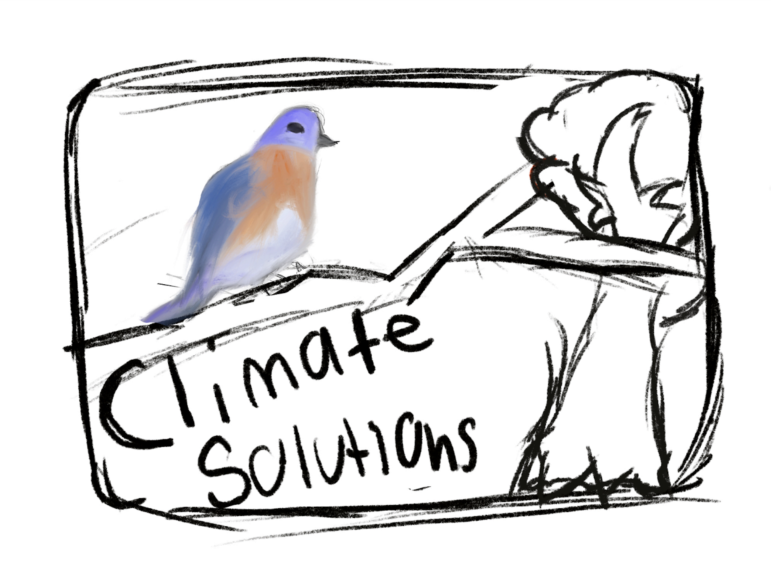By SHELDON KRAUSE
Capital News Service
LANSING – As Michigan feels the effects of a changing climate, agriculture experts say they can adapt to keep farms running.
Certain crops will be grown with less consistent yields, but those changes can also represent an opportunity for farmers willing to take advantage of the new conditions, experts say.
“The three greatest ways that we’re seeing impacts now are increased temperatures, increased rainfall and more intense rain events when we are having rain events,” said Kate Madigan, the director of the Michigan Climate Action Network, based in Traverse City
“We’re already seeing impacts on our agriculture, on our farms. The increased temperatures increase stress on plants, which can bring down the yield,” she said.
“There’s no contest in that respect,” said Phil Robertson, a researcher at Michigan State University’s Kellogg Biological Station in Hickory Corners. “The crops that are most vulnerable to climate change are the fruit crops.”
“We haven’t yet hit the point where the weather makes it unsuitable to grow fruit – but one can imagine that in 20 or 30 years we may get to that point, or more quickly than we want,” Robertson said.
Joseph Rivet, the deputy director of the state Department of Agriculture and Rural Development, also warned of biological threats that could come with climate change.
“We know that warmer, wetter climates spur plant disease and pest infestations,” he said. “That’s a concept that is just as relevant as a 2-degree temperature change 30 years from now.”
Aside from stopping climate change contributors all together, experts say some crops may have a new opportunity to flourish.
“Michigan is actually in a better place compared to other states because the warming that we’re seeing would allow farmers to have a little longer season,” said Bruno Basso, an MSU professor and researcher at the Kellogg Biological Station.
Farmers may be able to plant crops like corn a few weeks earlier in the year, which he says may benefit them.
Julie Doll, a former Kellogg researcher and the chief executive officer of Michigan Agriculture Advancement, an advocacy organization supporting “alternatives to the commodity agriculture system,” agreed: “We’re seeing a longer growing season, which sounds really great and, in some cases, absolutely can be an advantage.”
In the agricultural region south of Michigan, the Heartland, certain crops are growing in greater quantities than in Michigan: soybeans in Ohio, melons and mint in Indiana and much greater quantities of corn and pumpkin in Illinois, according to the U.S. Department of Agriculture..
“However, it can also be a longer season of risk, especially for perennial crops such as fruit trees, increasing their exposure to the risk of severe frost or freeze,” Doll said.
One idea discussed among experts is changing dominant crops in the region as environmental conditions become more favorable.
Robertson said, “One can look at crops in states a little bit farther south and see what kind of crops those might be.”
Looking at modern examples of farmers adapting to environmental conditions, Robertson said, “When you drive north now up the Lower Peninsula, you’ll see corn a lot farther north than you would have if you were making the same drive 30 years ago.”
Robertson’s observations reflect those made by the agriculture community in recent years about the so-called “corn belt,” the latitudinal region in the U.S. where corn grows best. It has been noticeably shifting north as the average temperatures across the nation rises.
A 2020 study from Pennsylvania State University found that ideal growing conditions for crops like corn, soybeans and sorghum will likely continue to climb northward, as seen in the unseasonably warm 2012 growing season.
In 2020, Michigan was 11th in corn production. It failed to rank in the top 11 in soybean production in 2020, but was 10th in 2000 and 2020, according to CropProphet. As growing conditions become more favorable in the state, it may be able to regain some of the market share it once had.
Basso also addressed the idea of shifting crops, cautioning that while it may be seen to some degree, “obviously we’re not talking about growing avocados.”
Farmers and agricultural communities need support to handle the changes that are coming, Doll said.
“We need better social networks for them,” she said. “We need to connect them better with each other to learn innovative ways of doing things.”
“We need to better support rural communities in which they live, so that we can have the strength of a more local or regional food economy where they have options of where to sell their products. And if they need to grow something different because of climate change, well, then they’re going to need a market for that,” she said.

Asher Freedman
Doll said she’s optimistic. “Ever since we as a species started to farm, we’ve adapted. Farming looks very different, even here in Michigan, in the last 50-100 years than it did before.”
“And so, agriculture can adapt really well to some of these slower changes.”
Sheldon Krause writes for Great Lakes Echo.